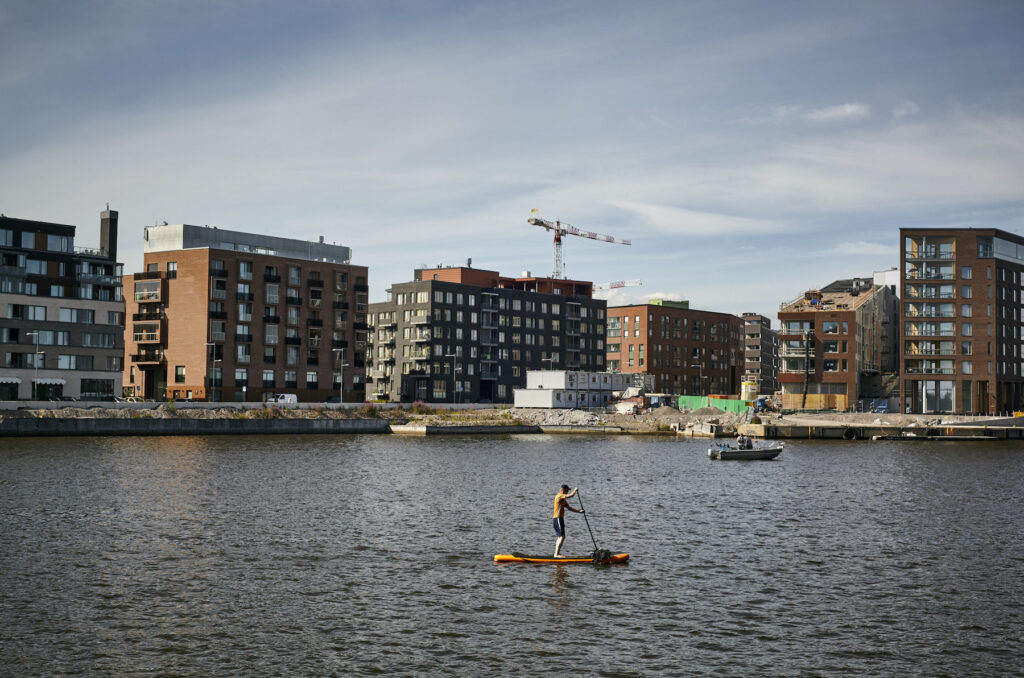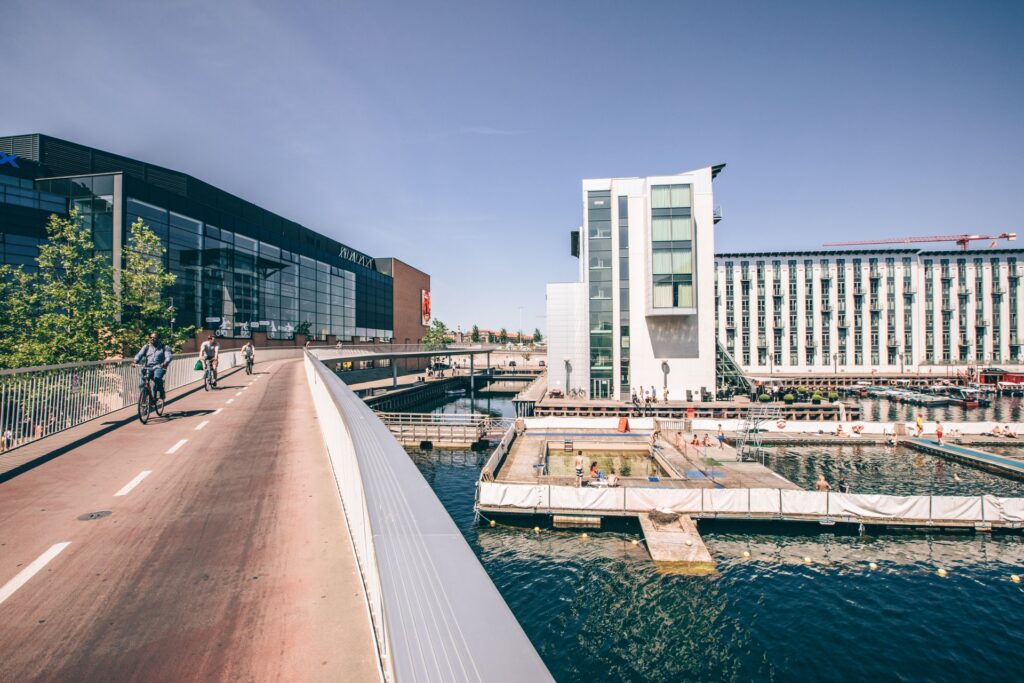In 2013, American political theorist Benjamin R. Barber convincingly argued that contemporary cities are better poised than nations to solve global problems. According to Barber, this is also true for the responses to climate change: ‘Where states can be said to have done the least, cities have done the most.’1
In the last decade, the climate strategies of both cities and nations have become more ambitious and more tangible. The forerunner cities have already been able to report evidence of success in their endeavours to reduce greenhouse gas (GHG) emissions.
The definition of smartness is also evolving. Some studies refer to smartness and sustainability as two separate domains without specifying how they relate to each other. When both frameworks are involved, Ahvenniemi et al. recommend to use the term ‘smart sustainable cities’ for clarity.2 Fu and Zhang propose in their analysis that the concept of smart city focuses on social rather than ecological aspects.3 According to a number of recent publications, cities are considered smart when information and communications technology (ICT) becomes a key enabler or major driver for sustainable transformation.4 This definition establishes a fundamental causality between the two concepts.
The European Smart City mapping has discovered a correlation between city size and the number of smart city characteristics.5 Largest cities tend to have the largest resources, and they are often also the forerunners in climate strategies.

Critical voices
Yigitcanlar and Kamruzzaman looked for a correlation between the smartness and sustainability of cities in the U.K. In their study, sustainability was represented by the trend of city’s annual GHG emissions. The indicators of smartness included inter alia the number of IP addresses. The researchers found no correlation and concluded: ‘D[d]espite to their promise, so far, smart city practices in the UK cities have failed to make a considerable contribution to the sustainability agenda beyond the rhetoric’.6
Critical voices go much further than this notion. French-British environmental journalist Natalie Sauer encourages the architectural community to fight in order to ‘oppose the rush towards “smart”, automated cities, whose voracious consumption of mineral resources is paving the way to horrors like deep-sea mining’.7
The Masdar City project in Abu Dhabi has further undermined the trust in new technologies and their ability to address the climate crisis. The outcome has been characterised as the ‘world’s first green ghost town’.8 The project will not reach carbon neutrality, which was one of its original goals.9
The sharp tone of the argumentation shows that the frontier between low-tech and high-tech approaches has not faded away in the discourse of sustainability.
In the following, we examine the climate strategies of three cities in order to demonstrate the roles that they assign to smartness. In Minneapolis, Helsinki and Copenhagen, the commitment to reduce GHG emissions has led to very different kinds of policies in spatial planning.
Minneapolis – no single-family houses in zoning
The city of Minneapolis in the U.S. gained world-wide attention when it decided to ban single-family houses in zoning in 2019.10 By banning single-family zoning, not only does Minneapolis aim to reduce GHG emissions, but also to support the provision of affordable homes and reduce segregation.11
Active climate work in Minneapolis started already in 1993. In 2017, Minneapolis was able to report that it has achieved its interim climate target for 2015, having managed to cut its GHG emissions by 15%.
Minneapolis published its Climate Action Plan in 2013, the same year in which Barber published his famous book about cities. The plan set up a roadmap listing 102 climate actions in various categories. Only eleven of these actions rely on new ICT solutions. The most important strategy in the Climate Action Plan concerns the energy efficiency of buildings, which is expected to bring about 66% of the desired GHG emission reductions.12
In 2014, Minneapolis declared that by 2050, it will cut its GHG emissions by 80%. Following this, in 2015-16 the Minneapolis Sustainability Office used Siemens’ free open source City Performance Tool (CyPT) to study more than 70 technologies in the building transport and energy sector at different time periods and implementation rates. The results showed that if the electricity mix gets significantly cleaner, the top-performing technologies for reducing carbon emissions would include electrifying both passenger and freight road transport and improving the energy efficiency of buildings, particularly of commercial and government buildings.
Helsinki – one million euros for a solution to replace coal
Helsinki has declared that it will be carbon neutral by 2035. To this end, Helsinki has prepared an action plan, which defines the concrete steps for reducing the GHG emissions of Helsinki by 80% in the next 15 years. The action plan consists of 147 initiatives in different sectors. After the reductions, the remaining 20% equals to approximately 700 kt of CO2. Helsinki aims to compensate for the remaining emissions entirely in 2035. The final target is to have no GHG emissions to compensate for.13
When the European Parliament made a comparison of the Smart City initiatives of 468 European cities, Helsinki was ranked in the top six.14 Given this, it is surprising that only 33 initiatives of the action plan rely on ICT.
Between 1990 and 2020, Helsinki has reduced its absolute GHG emissions by 25%. In this period, the population of Helsinki has increased by 15 000 citizens—thus, the GHG emissions per capita have actually fallen by approximately 40%.
Most of Helsinki’s GHG emissions are caused by energy consumption in buildings and traffic.15 Helsinki produces district heating in efficient combined heat and power (CHP) plants, but mainly from fossil fuels. A new law that bans the use of coal by 2029 entered into effect in 2019. To find a solution to replace fossil fuels in district heating, Helsinki has launched an international idea competition with a prize of one million euros. The winning team will be announced in March 2021. 16

Copenhagen – the first carbon neutral capital?
Copenhagen adopted its first climate plan in 2009. It declared a target to reduce its CO2 emissions by 20% by 2015. This target was achieved already in 2011. Since 1990, Copenhagen has reduced its carbon emissions by more than 40%.
In 2012, three years before the Paris Agreement was signed, the Copenhagen City Council adopted the CPH 2025 Climate Plan, which set a long-term goal of becoming the first carbon neutral capital by 2025. CPH 2025 Climate Plan is based on four pillars, which are energy consumption, energy production, mobility and city administration initiatives. Whereas Helsinki is planning to offset the remaining GHG emissions by compensations, Copenhagen plans to provide excess energy outside the city boundary as an offset.
By 2025, power and heat generation in Copenhagen will primarily be based on wind, biomass, geothermal energy and waste.17 One of the main initiatives in the energy consumption sector is developing Copenhagen into a smart city. According to the action plan, a digital infrastructure must be laid down for public data on electricity and heat consumption. This would improve the opportunities for flexible energy consumption and promote the concept of smart building.18
Leadership in climate action
The current GHG mitigation strategies and level of ambition in Minneapolis, Helsinki and Copenhagen seem to support Barber’s argument. These three cities have taken on the role of forerunner in GHG mitigation. And this development is indeed supported by networking: the cities are members of Carbon Neutral Cities Alliance (CNCA) and the Global Covenant of Mayors for Climate and Energy movement, connecting the local governments who are committed to go beyond their national climate and energy objectives.
Minneapolis has continued with its climate endeavours through the four years of president Trump’s administration, which has not supported CO2 reduction policies and decided to withdraw the U.S. from the Paris Agreement. Copenhagen aims to achieve carbon neutrality already in 2025, while the Danish national climate neutrality target is set for 2050. Helsinki aims to achieve climate neutrality by 2035, the same year as the state of Finland, but this target is much more ambitious within the city boundaries than in the context of other territories of this sparsely populated and forest-covered country.
There have been different kinds of responses to climate targets in spatial planning, for which GHG quantification has not provided very clear indications. Minneapolis relies on densification, whereas the city of Helsinki has made preparations to expand towards east.
The correlation between population density and GHG emission has been questioned in several studies. Heinonen and Junnila applied a tiered-hybrid-LCA method to compare GHG emissions and urban density. This method differs from the GHG quantification methods applied by cities. The researchers conclude that urban density has very little effect on carbon emissions.19 The results were also noted in the 5th IPCC report.

The role of smartness in climate strategies
The climate strategies of the above-mentioned cities have plenty of similarities, but smartness plays a major role only in Copenhagen’s action plan. The most recent action plans are spearheaded by energy transformation, which has an overarching impact on buildings and traffic.
Cities are transitioning from fossil fuels to low-carbon energy sources, including renewable energies. Smart grid is needed to cut the peak loads and address the load match problem between energy consumption and renewable energy production. The number of combustion engines in city traffic can be reduced with the help of new ICT-based solutions, such as mobility-as-a-Service (MaaS).
Thus, for those who do not believe in the vision of ICT-driven future cities, three functions with significant GHG reduction potential can be pinpointed:
- Informing planners and policy-makers through modelling of processes and GHG quantification.
- Enabling energy transformation in cities (smart grid).
- Providing services that increase the modal share of public transportation, biking and MaaS solutions.
The GHG methodologies of cities neglect the impact of personal consumption, which is high in urban environments. We should not underestimate the potential of voluntary action and changes in consumption patterns.20 To this end, citizens need to be motivated and provided with accurate real-time information on the climate impacts of their consumption and choices in everyday life. According to Säynäjoki, encouraging more sustainable lifestyles presents an untapped potential for addressing environmental problems in urban planning.21 This can be named as the fourth important function of smart technologies in mitigating the GHG emissions of cities.

Architect and professor KIMMO LYLYKANGAS is the head of Academy of Architecture and Urban Studies at TalTech. Sustainable built environment has been the focus of his work as a practising architect, researcher and educator for 20 years. His current research interests include greenhouse gas quantification in spatial planning and the digitalisation of urban green.
HEADER: Jätkäsaari new residential district in Helsinki. Photo: Jussi Hellsten
PUBLISHED: Maja 103 (winter 2021) Smart Living Environment
1 Benjamin R. Barber, If Mayors Ruled the World: Dysfunctional Nations, Rising Cities (New Haven & London: Yale University Press, 2013), 130
2 Hannele Ahvenniemi, Aapo Huovila, Isabel Pinto-Seppä & Miimu Airaksinen, „What are the differences between sustainable and smart cities?“, Cities 60, Part A (February 2017): 234–245.
3 Yang Fu & Xialoing Zhang, „Trajectory of urban sustainability concepts: A 35-year bibliometric analysis,“ Cities 60, Part A (February 2017): 113–123
4 Catriona Manville, jt. Mapping Smart Cities in the EU. (Directorate General for Internal Policies, Policy Department A: Economic and Scientific Policy, 2014).
5 Catriona Manville, jt. Mapping Smart Cities in the EU. (Directorate General for Internal Policies, Policy Department A: Economic and Scientific Policy, 2014).
6 Tan Yigitcanlar & Mohammed Kamruzzaman, „Does smart city policy lead to sustainability of cities?“, Land Use Policy 73, (2018): 49–58.
7 Natalie Sauer, „Wanted: Climate leadership,“ Topos 110 (2020).
8 Suzanne Goldenberg, „Masdar’s zero-carbon dream could become world’s first green ghost town,“ Guardian, 16. veebruar, 2016, https://www.theguardian.com/environment/2016/feb/16/masdars-zero-carbon-dream-could-become-worlds-first-green-ghost-town
9 Steven Griffiths & Benjamin K. Sovacool, „Rethinking the future low-carbon city: Carbon neutrality, green design, and sustainability tensions in the making of Masdar City,“ Energy Research & Social Science 62 (April 2020).
10 Minneapolis 2040 – The City’s Comprehensive Plan (Minneapolis City Council, 2019).
11 Richard D. Kahlenberg, „How Minneapolis Ended Single-Family Zoning,“ Rights & Justice Report, The Century Foundation, 2019, https://tcf.org/content/report/minneapolis-ended-single-family-zoning/?agreed=1
12 Minneapolis Climate Action Plan. A roadmap to reducing citywide greenhouse gas emissions (2013).
13 The Carbon-neutral Helsinki 2035. Action Plan (Publications of the Central Administration of the City of Helsinki, 2018).
14 Catriona Manville, jt, ‘Mapping Smart Cities in the EU’ (Directorate General for Internal Policies, Policy Department A: Economic and Scientific Policy, 2014).
15 The Carbon-neutral Helsinki 2035. Action Plan (Publications of the Central Administration of the City of Helsinki, 2018).
16 Helsinki Energy Challenge. https://energychallenge.hel.fi/
17 CPH2025 Climate plan. A green, smart and carbon neutral city, 14.
18 CPH2025 Climate plan. A green, smart and carbon neutral city, 34.
19 Jukka Heinonen & Seppo Junnila, „Implications of urban structure on carbon consumption in metropolitan areas,“ Environmental Research Letters 6 (2011): 6–7.
20 One Tonne Life. Final Report. http://www.idrv.org/wp-content/uploads/One_Tonne_Life-Final-Report.pdf
21 Eeva-Sofia Säynäjoki, “The Untapped Potential of Urban Planning: Achieving Greater Success in Environmental Sustainability” (PhD diss., Aalto Ülikool, 2015), 40.







